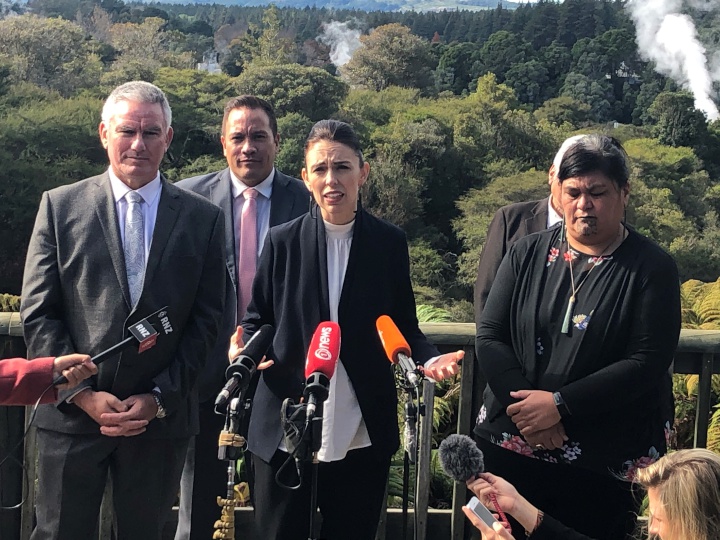NZMACI mandate protected with Government fund

Sir Āpirana Ngata’s vision of ensuring the protection and perpetuation of Māori art and craft will live on – despite the impact of COVID-19 – thanks to a $7.6 million Government contribution for the New Zealand Maori Arts and Crafts Institute (NZMACI), located at Te Puia in Rotorua.
The $7.6 million contribution – to be
paid over two years – is part of the Government’s
Rebuilding Together Budget. Minister Nanaia Mahuta confirmed
the details during a site visit to Te Puia | NZMACI today
< NZMACI was first
established in 1926 under the guidance of Sir Āpirana
Ngata, who recognised that Māori arts and culture were
integral to preserving tribal knowledge and identity. NZMACI was officially combined with Te Whakarewarewa
Valley’s tourism interests in 1963 under Government
legislation. It now houses Te Wānanga Whakairo Rākau o
Aotearoa | The National Wood Carving School, Te Rito | The
National Weaving School, Te Tapuwae o te Waka | The National
Canoe School, Te Takapū-o-Rotowhio | The National Stone and
Bone Carving School ('Te Takapū’) and Te Ahi Kōmau
(casting workshop). Today, NZMACI’s legislative
mandate is financially supported by Te Puia, one of Aotearoa
New Zealand’s most iconic visitor destinations. However,
due to the obvious impacts of COVID-19, the visitor
operation closed its doors in March and is not expected to
open for several months.
Te Puia | NZMACI Chief
Executive, Tim Cossar says the Government’s funding
package will literally ensure the survival of the
Institute’s cultural activities for the next two years,
while it’s visitor operation reboots and recovers. “Like every other visitor attraction in New Zealand,
we have been significantly impacted by COVID-19. However,
unlike any other tourism business, our activity also
includes a cultural protection and development operation
that is mandated under law. “Since 1963, our
cultural Institute has been self-funded thanks to millions
of manuhiri since then from around New Zealand and the
world. Understandably, this has been under threat in recent
months and our Schools were closed as a result in March. “This has been a tough period for everyone involved
with Te Puia | NZMACI and the hard times are not yet over.
Tourism markets have stopped and our business, as we knew
it, became unviable to remain open. “But thanks to
this contribution from the New Zealand Government, we can
safeguard the ongoing development of Māori art and craft,
and ensure its longevity under Sir Āpirana Ngata’s
original vision,” says Mr Cossar. Mr Cossar says
some of NZMACI’s master carvers and heads of schools had
been retained during its forced restructure two months ago,
however, the funding will allow it to progressively build
back capability throughout 2020 and beyond. “In
the meantime, we are working extremely hard to ensure we are
in the best place possible to provide a contemporary Māori
and geothermal offering for our domestic – and eventually
international – visitor market once again. “Many
of our whānau are just the latest in several generations to
carve and/or guide in Te Whakarewarewa Valley – and they
won’t be the last. The legacy of this place stems back
nearly 150 years, when guides were first hosting manuhiri to
the Pink and White Terraces. “The plans and
changes we make now will ensure that this legacy continues
for another 150 years.”


 PPTA Te Wehengarua: Draft English Curriculum Lacks Connection With Reality
PPTA Te Wehengarua: Draft English Curriculum Lacks Connection With Reality Oratia Books: Revised Edition Of Much-praised History Examines The Great War Experience Of New Zealand, Australia And Canada
Oratia Books: Revised Edition Of Much-praised History Examines The Great War Experience Of New Zealand, Australia And Canada Brain Injury NZ: Creating Solutions - ID Card For People With Brain Injury Launched
Brain Injury NZ: Creating Solutions - ID Card For People With Brain Injury Launched University of Auckland: AI Leads To Breakthrough In Knee Surgery
University of Auckland: AI Leads To Breakthrough In Knee Surgery The Label: Independent Music NZ Announces Taite Music Prize IMNZ Classic Record 2025
The Label: Independent Music NZ Announces Taite Music Prize IMNZ Classic Record 2025 Protect NZ Psychology: Psychologists Warn Of Patient Risk From Undertrained Workforce
Protect NZ Psychology: Psychologists Warn Of Patient Risk From Undertrained Workforce